② 中国科学院地质与地球物理研究所, 新生代地质与环境重点实验室, 北京 100029;
③ 澳大利亚国家原子能研究中心环境研究所, ANSTO, PMB1, Menai 2234, Australia)
河流阶地可以提供丰富的构造运动和气候变化信息,因此对阶地形成时代和演化过程的研究是新构造和古气候变化研究中的重要内容。在中国北方干旱-半干旱地区河流阶地的研究中,古地磁方法及黄土-古土壤序列对比是较常用的相对测年手段[1, 2]。近30年来光释光(OSL)和电子自旋共振(ESR)技术的发展为晚更新世至中早更新世以来阶地沉积物的绝对测年提供了可能[3~6]。但由于上述测年方法的测年对象主要为砂质碎屑沉积,很难对以砾石堆积为主的阶地进行定年。近年来有学者利用地表生成的10 Be来研究我国西南三江地区基座阶地面上巨型漂砾的暴露年龄和长江流域的侵蚀速率[7, 8]。宇宙成因核素埋藏测年是在暴露测年基础上发展起来的基于同位素衰变原理的测年方法[9~13],它是利用近地表矿物在次级宇宙射线轰击下在内部生成的多种宇宙成因核素来进行定年,其中10 Be和26 Al这两种核素目前较为常用。石英矿物在高纬度海平面地区每年生成26 Al原子和10 Be原子之比约为6.75[14],暴露在宇宙射线下的石英矿物在积累了一定量的26 Al和10 Be后被快速深度埋藏,随后矿物中便不再产成新的26 Al和10 Be,两者会根据其各自的半衰期不断衰减(10 Be的半衰期约为1.36Ma,26 Al的半衰期约为0.71Ma)[15~17],通过测定石英样品中26 Al和10 Be的浓度和比值就可以计算出样品的埋藏时间。26 Al/10 Be埋藏测年物理机制较明确,影响因素少,测年时段较广(约0.2~5.0Ma),且测年所需的石英样品较易获取。目前26 Al/10 Be埋藏测年方法已成功应用于国内外一些重要考古遗址和地貌演化的年代学研究[18~21]。本研究采用26 Al/10 Be埋藏测年对黄河上游宁夏沙坡头地区的砾石堆积阶地开展了定年工作,获得了不同阶地的形成时代。
2 研究区简介研究区位于宁夏回族自治区中卫市西南约20km处的沙坡头一带,构造位置上处于青藏高原东北缘弧形构造带内的香山-天景山断裂中段与中卫盆地的交接部位(图 1)[22]。黄河在宁夏沙坡头一带自西向东穿过香山-天景山断裂并在断裂上升盘夜明山一带的黄河干流左岸形成9级阶地(图 2)。因该区黄河阶地对构造运动的响应比较敏感,所以其形成时代可以反映香山-天景山断裂活动的不同期次。该区阶地堆积主要以黄河砾石堆积为主(尤其是高级阶地),含较薄的砂层或砂透镜体(图 3)。邢成起等[23]通过测量砾石钙膜厚度结合ESR测年得到研究区T2~T11黄河阶地的年龄序列从18ka至1.57Ma(T10、 T11阶地据黑山峡口以西约8km);张珂和蔡剑波[24]尝试利用宇宙成因核素方法对研究区西北方向拔河约247m的黑山峡一带最高级基岩阶地(T11)样品进行分析,获得其年代约为2.4Ma;尹功明等[25]利用光释光方法对本研究区T4~T8阶地的砂层测年研究发现除T4阶地的河流相砂层(约166ka)外,T5~T8级阶地的砂层年龄均不超过74ka,大部分年龄处于末次冰期早期,说明这些砂层反映的是末次冰期风力作用的增强而非河流阶地伴生的冲积产物。对研究区采样阶地的拔河高度、砾石层厚度及沉积特征描述见表 1。

|
图 1 沙坡头黄河阶地构造位置(a)及卫星影像(b)[25] (a)青藏高原东北侧的弧形挤压-走滑活动断裂带及香山-天景山断裂带的分段1.第四纪拗陷盆地区(Quaternary depression basin);2.基岩山地区(Bedrock mountain);3.陇西高地(Longxi highland);4.活动断层(Active fault);5.背斜(Anticline) Fig. 1 Tectonic location (a) and satellite image (b) of studied area. (a)Major active faults of the arc fault zone on the north-eastern margin of the Qinghai-Tibet Plateau amd Xiangshan-Tianjingshan Fault |

|
图 2 研究区夜明山山前黄河阶地纵剖面示意图 Fig. 2 The Yellow River terraces near Yemingshan Mountain in this study |

|
图 3 沙坡头T8阶地砾石堆积剖面采样照片 Fig. 3 The photo of sampling section of Shapotou T8 Yellow River terrace |
| 表 1 宁夏沙坡头采样黄河阶地(左岸上升盘)信息 Table 1 The features of Yellow River terraces(left bank)in Shapotou area, Ningxia |
本研究测年样品采集自黄河左岸断层上升盘夜明山一带T5~T9四级高阶地的砾石层(T7阶地因未出露新鲜剖面没有采集样品)及现代河漫滩堆积剖面上的石英质砾石;低阶地T1~T4由于之前已开展过OSL测年工作[25]且阶地估计年龄小于26 Al/10 Be埋藏测年的下限(约200ka),故未采集砾石样品。采样剖面为2012年煤矿修路时开挖,经简单清理后可直接采集样品。由于研究区处于黄河流出黑山峡的出谷口,水动力条件在现今和历史时期都较强,故阶地堆积物以砾石为主,砾石磨圆度较好,分选较差,大小混杂,其间夹杂少量砂层和砂透镜体。采样时主要选取质量在100g以下的石英质砾石,并按粒径分为10~20mm和30~40mm两组,样品分别标注S(或M)和L,样品采集位置参见表 2。砾石样品首先粉碎过筛,选取粒径250~500μm的颗粒,再进行磁选,然后分别用盐酸和HF/HNO3混合酸先后超声浸泡刻蚀以去除其中的碳酸盐和长石等杂质矿物以及石英表面大气成因的10 Be。提纯后的石英矿物利用电感耦合等离子体发射光谱仪(ICP-OES)进行了纯度检验(均小于150 ppm),在澳大利亚原子能研究中心环境研究所(ANTARES)进行了Be和Al的核素化学分离,并在ANTARES的加速器上进行了测试[26, 27]。
| 表 2 沙坡头黄河阶地砾石样品10 Be和26 Al测量结果 Table 2 AMS analysis results of 10 Be and 26 Al of the gravel samples in this study |
简单快速埋藏模式(simple burial model)是26 Al/10 Be埋藏测年中一种最理想的情况。采用简单快速埋藏模式计算样品26 Al/10 Be埋藏年龄的前提是样品在暴露一段时间后被快速深埋[11]。由于26 Al/10 Be在埋藏前的初始浓度比等于它们的产率之比(约6.75),所以通过现今实测的26 Al/10 Be浓度比就可以计算出样品的埋藏时间[11]。具体公式如下:

|
(1) |
将公式(1)中的两式相比可得:

|
(2) |
公式(2)中NAl (t)/NBe (t)为实测核素浓度比,NAl(0)/NBe(0)为初始核素浓度比,PAl/PBe为核素产率比,λBe和λAl分别为10 Be和26 Al的衰变常数,故可以求解式中唯一的未知数埋藏时间t。
如果要考虑样品埋藏前和埋藏后的侵蚀速率,那么公式(1)中初始核素浓度可用下式表示[28, 29]:

|
(3) |
样品经过埋藏时间t后的核素浓度可以表示为:
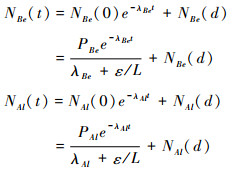
|
(4) |
公式(3)和(4)中,N(d)为埋藏后生成核素浓度,ε为暴露前侵蚀速率,L为宇宙射线粒子的衰减长度,一般取160/ρ cm[9],ρ为上覆沉积物密度。
如果样品埋藏后的地表侵蚀速率与样品暴露前的侵蚀速率不相同,则埋藏后生成核素浓度N(d)可以用下式表示:

|
(5) |
公式(5)中E为样品埋藏后的地表侵蚀速率,d为样品埋深。将公式(5)代入(4)可以得到:
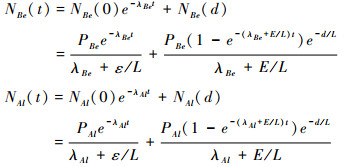
|
(6) |
公式(6)中共有3个未知量:样品暴露前侵蚀速率ε,埋藏后侵蚀速率E和样品埋藏时间t。假定一个合理的埋藏后侵蚀速率E,通过26 Al和10 Be核素对就可以迭代求解出样品暴露前侵蚀速率ε和样品埋藏时间t。
若样品埋藏后并非被快速深埋而是逐渐被埋藏,就需要考虑上覆堆积物的堆积速率,此时样品在埋藏过程中累积的核素浓度可以表示为:
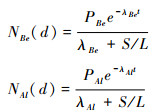
|
(7) |
公式(7)中S为样品埋藏后的堆积速率,如果将公式(7)代入式(4)可以得到:
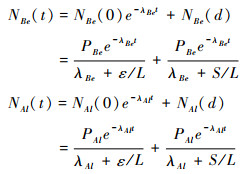
|
(8) |
公式(8)中共有3个未知量:样品暴露前的侵蚀速率ε,样品埋藏后的沉积速率S和样品的埋藏时间t。如果我们给定一个合理的沉积速率S,就可以解算出ε和t。
通过对沙坡头黄河阶地高阶地采样剖面的野外观察和样品现今埋深分析,我们认为阶地砾石在埋藏过程中上覆堆积以接受后期剥蚀作用为主(如最高级T9阶地面上堆积的砾石层厚度仅3~4m),故采用公式(6)进行样品年代计算。
4 结果与讨论通过将不同阶地砾石样品的26 Al/10 Be和10 Be浓度投影至埋藏测年曲线图,可以发现河漫滩的两个砾石样品的26 Al/10 Be比值和误差棒均落在“持续暴露”曲线上,表明河漫滩砾石样品基本未被埋藏(图 4)。我们首先利用简单快速埋藏模式对砾石样品的年龄进行了计算,由于简单快速埋藏模式的假设前提是样品的26 Al/10 Be初始浓度之比为6.75[14],如果样品在最后一次埋藏前经历过多次埋藏,那么它的26 Al/10 Be初始浓度比就会小于6.75。我们对河漫滩两种不同粒径砾石样品的26 Al/10 Be初始浓度比做加权平均得到的比值为6.34±0.42,说明样品基本没有被埋藏或只经历过短暂埋藏。如果假设高阶地与河漫滩的砾石样品的来源相同并且它们最后一次埋藏前的暴露埋藏史也相同,那么它们的26 Al/10 Be初始核素浓度比也是相同的。采用简单埋藏模式(公式(2))根据同一阶地两组砾石样品26 Al/10 Be核素浓度比的平均值计算得到的砾石样品的埋藏年龄结果分别约为0.25Ma、 0.36Ma、 0.59Ma和1.06Ma(表 2)。
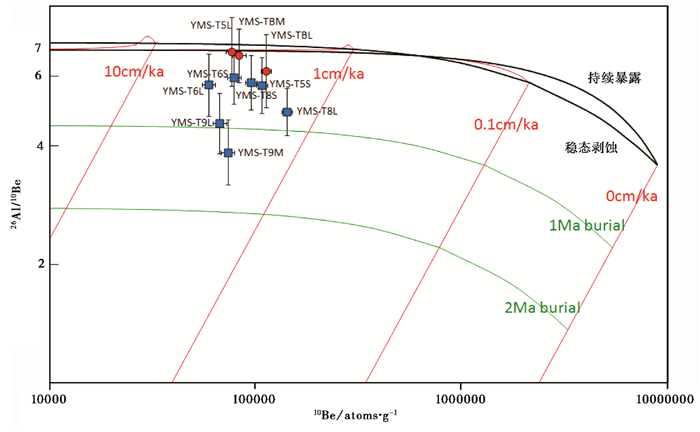
|
图 4 沙坡头黄河阶地砾石样品26 Al/10 Be比值与10 Be浓度关系曲线图 两条黑色曲线分别表示“稳态剥蚀”和“持续暴露”模式,绿线为样品埋藏等时线,红线表示样品埋藏前接受的不同剥蚀速率,红色圆点表示未埋藏或只经过短时间埋藏的样品 Fig. 4 Plot of 26 Al/10 Be ratio and 10 Be concentration in Shapotou Yellow River terraces gravel samples. "Steady erosion" and "constant exposure" are indicated by black curves, burial age isochrons are shown with green curves and different pre-burial erosion rates with red lines |
由于本研究中的几级阶地采样深度均不足10m,所以需要考虑埋藏后生成核素对埋藏年龄的影响。上述表 2中采用简单埋藏模式给出的只是样品的最小埋藏年龄。对于本文中埋深较浅的黄河阶地样品,可以通过假定一个最小侵蚀速率来计算获得样品埋藏后的最大核素生成量,进而获得样品的最大埋藏年龄。本文中假定研究区的最小剥蚀速率(E)为5m/Ma[30]并计算了样品对应的最大埋藏年龄。为了进行对比,我们还分别计算了侵蚀速率为15m/Ma和100m/Ma时对应的样品埋藏年龄(见表 3)。根据不同学者对沙坡头地区最高一级黄河阶地地表样品的宇宙成因核素浓度分析[24, 30],该地区地表剥蚀速率约在5~15m/Ma。从表 3可以看出,当样品埋深越浅时,埋藏后侵蚀速率的变化对埋藏年龄计算结果影响越大。考虑到研究区黄河阶地在形成历史过程中其砾石层顶部曾覆盖有较厚的风成砂堆积层[25],这些风砂堆积在阶地形成后期以接受剥蚀为主,上覆风成堆积被逐渐剥蚀而出露下覆的砾石层(在野外可观察到阶地砾石层顶部有较薄的风成堆积物),所以这些厚层风成堆积在砾石样品埋藏过程中会对宇宙射线起到一定的屏蔽作用[30]。根据样品埋藏后的剥蚀速率和埋藏年龄计算出的样品初始埋藏深度,结合野外实测的阶地面和基座拔高,我们认为剥蚀速率(E)为5m/Ma下获得的阶地砾石层堆积厚度较为合理(< 20m),得到的埋藏年龄也应更接近样品的实际年龄,分别约为0.42Ma、 0.39Ma、 1.02Ma和1.59Ma(表 3)。
| 表 3 宁夏沙坡头阶地砾石样品在不同地表侵蚀速率下的埋藏年龄 Table 3 Burial ages of Shapotou gravel samples obtained by different post-burial erosion rates |
通过将本文得到的26 Al/10 Be埋藏年龄与前人采用砾石钙膜厚度与ESR测年相结合的方法[23]得出的阶地年龄对比发现: T5、 T6和T8阶地的26 Al/10 Be最小埋藏年龄与砾石钙膜年龄在误差范围内基本一致,但T9阶地的26 Al/10 Be埋藏年龄(约1.06Ma)要明显老于砾石钙膜年龄(742ka)[23]。需要指出的是,砾石表面钙膜是由土壤中的钙质淀积形成的,其生长发育会受到气候、环境、时间等多种因素的影响,在长时间的形成过程中钙层可能会存在间断或缺失,从而导致通过测量钙膜厚度获得的样品年龄偏年轻;另一方面,Hu等[31]的研究发现兰州一带的黄河高级地的年龄系统性的老于古地磁年龄,并认为这可能是由于上游存在沉积盆地所致。由于本研究区位于兰州下游约300km,根据砾石的搬运过程判断,本区的砾石来源可能与兰州一带阶地的砾石并不相同,另外通过我们对夜明山黄河现代河漫滩砾石样品的26 Al/10 Be分析(表 2)。砾石样品的初始核素浓度比在误差范围内接近于石英矿物在高纬度海平面地区每年生成26 Al/10 Be原子之比6.75[14],即之前未经历过显著的埋藏,所以我们认为采用6.75作为初始26 Al/10 Be比计算高阶地砾石样品的埋藏年代是合理的。
对于埋深较浅的T8和T9阶地样品,埋藏后期剥蚀作用对埋藏年龄计算的影响比埋深较深的T5和T6阶地更大。由于中子在不同介质中的自由行程约为160/ρ cm[9],如果我们假设阶地上覆砂砾石堆积的密度ρ≈2g/cm-3,则中子在地表下的衰减深度约为80cm,那么对于本研究中的阶地样品,中子的贡献可以忽略。但由于μ介子的穿透能力很强[9~11],所以μ介子对核素生成的贡献必须考虑。目前对于μ介子对核素产率的贡献随深度的变化尚不十分明确,不同学者所采用的计算模型之间存在一定差异[32~35]。另外在样品埋藏过程中上覆沉积物由于堆积、侵蚀和风化等作用导致的厚度和密度随时间的变化通常都带有一定的不确定性,使得对后期生成核素的准确限定比较困难。Balco和Rovey[36]提出采用等时线的方法来解决上述问题。这种方法是通过分析同一深度的多个样品,并将其10 Be和26 Al的浓度分别投影在XY图上,从获得的直线斜率可以计算出样品的埋藏年代,直线的截距反映了后期生成核素量。采用等时线方法的一个前提是被分析样品的初始核素浓度应有比较大的差异,才能保证等时线的拟合精度。本研究由于采集的样品有限,未采用等时线方法,采用简单快速埋藏模式获得的阶地年龄为最小埋藏年龄。
与一些山前快速埋藏的砾石堆积(如西域砾岩[37])相比,沙坡头地区的黄河阶地砾石由于搬运距离相对较远,其初始核素浓度相对较高。近年来国外一些学者对不同粒径的砂和砾石的核素浓度开展了相关的对比分析研究[38~40],但由于受物源、源区海拔和侵蚀速率等诸多因素的影响,在一些重力和流水搬运共同作用的地区,沉积物核素浓度与粒径之间并不一定会呈现明显的相关性,而针对不同粒径大小砾石样品的埋藏测年研究尚显有报道。本研究对不同阶地砾石样品按粒径大小分组分别进行了AMS测量分析,从分析结果来看尽管同一级阶地大小砾石的核素浓度存在一定的差异但两者的26 Al/10 Be比值在误差范围内是基本一致的(表 2)。鉴于本研究中样本数量有限,对于砾石粒径对26 Al/10 Be测年的影响还有待进一步深入研究。
5 结论本文采用26 Al/10 Be埋藏测年方法对宁夏中卫沙坡头一带的黄河阶地砾石层进行了年代学研究。采用简单埋藏模式获得的T5、 T6、 T8和T9四级阶地的年龄分别约为0.25Ma、 0.36Ma、 0.59Ma和1.06Ma,与阶地的层序一致。考虑后期剥蚀影响,利用已获得的该地区的最小剥蚀速率(5m/Ma)计算获得的阶地年龄分别约为0.42Ma、 0.39Ma、 1.02Ma和1.59Ma,其中由于T8和T9阶地样品埋深较浅,其埋藏年龄受后期剥蚀速率影响较大。T9阶地的26 Al/10 Be埋藏年龄明显老于砾石钙膜年龄,考虑到钙膜在生长过程中由于受气候环境和剥蚀作用影响可能导致不同时期生长厚度的不均一,及前人对相邻地区最高级基岩阶地的宇宙成因核素测年结果[24],我们认为T9阶地的26 Al/10 Be埋藏年龄更为可靠。
在本研究中并没有发现砾石的粒径与其核素浓度和埋藏年龄有明显的相关性,为了获得更准确和精细的阶地年龄,我们建议在同一阶地上尽量采集多个样品(把相似粒径的多个砾石作为一个样品)进行分析,采样时避免采集过大的石英砾石(单位质量核素浓度较低)。同时,如果需考虑埋藏后生成核素的影响,则可以采集剖面同一层位的多个石英砾石样品采用等时线方法分析计算。
致谢: 本文的野外考察和样品实验室分析工作得到了中卫地震台贺永章台长、南京师范大学沈冠军教授、中国地质大学(武汉)涂华博士等的帮助,美国普度大学Darryl Granger教授参与了数据的讨论与计算,在此一并表示由衷感谢。
| 1 |
Li J J, Fang X M, Van der Voo R, et al. Magnetostratigraphic dating of river terraces:Rapid and intermittent incision by the Yellow River of the northeastern margin of the Tibetan Plateau during the Quaternary.
Journal of Geophysical Research:Solid Earth,1997, 102 (B5) : 10121~10132.
doi:10.1029/97JB00275 ( 0) 0)
|
| 2 |
Pan B, Su H, Hu Z, et al. Evaluating the role of climate and tectonics during non-steady incision of the Yellow River:Evidence from a 1.24Ma terrace record near Lanzhou, China.
Quaternary Science Reviews,2009, 28 (27) : 3281~3290.
( 0) 0)
|
| 3 |
Huntley D J, Godfrey-Smith D I, Thewalt M L. Optical dating of sediments.
Nature,1985, 313 : 105~107.
doi:10.1038/313105a0 ( 0) 0)
|
| 4 |
Roberts R G, Lian O B. Dating techniques:Illuminating the past.
Nature,2015, 520 (7548) : 438~439.
doi:10.1038/520438a ( 0) 0)
|
| 5 |
Yokoyama Y, Falgueres C, Quaegebeur J-P. ESR dating of quartz from Quaternary sediments:First attempt.
Nuclear Tracks and Radiation Measurements,1985, 10 (4) : 921~928.
( 0) 0)
|
| 6 |
Rink W, Bartoll J, Schwarcz H, et al. Testing the reliability of ESR dating of optically exposed buried quartz sediments.
Radiation Measurements,2007, 42 (10) : 1618~1626.
doi:10.1016/j.radmeas.2007.09.005 ( 0) 0)
|
| 7 |
吕延武, 顾兆炎, 许冰, 等. 云南怒江丙中洛河段第三级阶地10Be暴露年龄.
第四纪研究,2012, 32 (3) : 403~408.
Lü Yanwu, Gu Zhaoyan, Xu Bing, et al. 10Be dated boulders from the third terrace of Nujiang River at Bingzhongluo, Yunnan Province, China. Quaternary Sciences,2012, 32 (3) : 403~408. (  0) 0)
|
| 8 |
黄湘通, 郑洪波, ChappellJohn, 等. 长江流域河流沉积物宇宙成因核素10Be特征与侵蚀速率估算.
第四纪研究,2013, 33 (4) : 671~683.
Huang Xiangtong, Zheng Hongbo, Chappell John, et al. Characteristics of cosmogenic nuclide 10Be in the Yangtze Riverine sediments and estimations of erosion rate. Quaternary Sciences,2013, 33 (4) : 671~683. (  0) 0)
|
| 9 |
Gosse J C, Phillips F M. Terrestrial in situ cosmogenic nuclides:Theory and application.
Quaternary Science Reviews,2001, 20 (14) : 1475~1560.
doi:10.1016/S0277-3791(00)00171-2 ( 0) 0)
|
| 10 |
Dunai T J.
Cosmogenic Nuclides:Principles, Concepts and Applications in the Earth Surface Sciences. Cambridge: Cambridge University Press, 2010 : 1 ~187.
( 0) 0)
|
| 11 |
Granger D E, Muzikar P F. Dating sediment burial with in situ-produced cosmogenic nuclides:Theory, techniques, and limitations.
Earth and Planetary Science Letters,2001, 188 (1) : 269~281.
( 0) 0)
|
| 12 |
沈冠军. 原地宇生核素埋藏测年法:最新进展及其在中国早期人类遗址年代研究中的应用前景.
第四纪研究,2012, 32 (3) : 382~387.
Shen Guanjun. In situ cosmogenic nuclide burial dating:Recent progresses and prospects in chronological studies of early hominin sites in China. Quaternary Sciences,2012, 32 (3) : 382~387. (  0) 0)
|
| 13 |
孔屏. 宇宙成因核素埋藏年龄法:原理及应用.
第四纪研究,2012, 32 (3) : 388~393.
Kong Ping. Cosmogenic nuclide burial dating:Theory and application. Quaternary Sciences,2012, 32 (3) : 388~393. (  0) 0)
|
| 14 |
Balco G, Stone J O, Lifton N A, et al. A complete and easily accessible means of calculating surface exposure ages or erosion rates from 10Be and 26Al measurements.
Quaternary Geochronology,2008, 3 (3) : 174~195.
doi:10.1016/j.quageo.2007.12.001 ( 0) 0)
|
| 15 |
Nishiizumi K, Imamura M, Caffee M W, et al. Absolute calibration of 10Be AMS standards.
Nuclear Instruments and Methods in Physics Research Section B: Beam Interactions with Materials and Atoms,2007, 258 (2) : 403~413.
doi:10.1016/j.nimb.2007.01.297 ( 0) 0)
|
| 16 |
Chmeleff J, von Blanckenburg F, Kossert K, et al. Determination of the 10Be half-life by multicollector ICP-MS and liquid scintillation counting.
Nuclear Instruments and Methods in Physics Research Section B: Beam Interactions with Materials and Atoms,2010, 268 (2) : 192~199.
doi:10.1016/j.nimb.2009.09.012 ( 0) 0)
|
| 17 |
Phillips F M, Argento D C, Balco G, et al. The CRONUS-Earth project:A synthesis.
Quaternary Geochronology,2016, 31 : 119~154.
doi:10.1016/j.quageo.2015.09.006 ( 0) 0)
|
| 18 |
刘彧, 王世杰, 刘秀明, 等. 贵州荔波黑洞碎屑沉积物宇宙成因核素26Al/10Be埋藏年龄.
第四纪研究,2013, 33 (3) : 437~444.
Liu Yu, Wang Shijie, Liu Xiuming, et al. Cosmogenic nuclides 26Al and 10Be burial age of Black Cave sediments, Libo of Guizhou, China. Quaternary Sciences,2013, 33 (3) : 437~444. (  0) 0)
|
| 19 |
Shen G, Gao X, Gao B, et al. Age of Zhoukoudian Homo erectus determined with 26Al/10Be burial dating.
Nature,2009, 458 (7235) : 198~200.
doi:10.1038/nature07741 ( 0) 0)
|
| 20 |
Davis M, Matmon A, Fink D, et al. Dating Pliocene lacustrine sediments in the central Jordan Valley, Israel-Implications for cosmogenic burial dating.
Earth and Planetary Science Letters,2011, 305 (3) : 317~327.
( 0) 0)
|
| 21 |
Matmon A, Stock G M, Granger D E, et al. Dating of Pliocene Colorado River sediments:Implications for cosmogenic burial dating and the evolution of the lower Colorado River.
Geological Society of America Bulletin,2012, 124 (3~4) : 626~640.
( 0) 0)
|
| 22 |
张维岐, 焦德成, 柴炽章, 等. 宁夏香山-天景山弧形断裂带新活动特征及1709年中卫南71/2级地震形变带.
地震地质,1988, 10 (3) : 12~20.
Zhang Weiqi, Jiao Decheng, Chai Chizhang, et al. Neotectonic features of the Xiangshan-Tianjingshan arc fracture zone and the seismic deformation zone of 1709 south of Zhongwei M=71/2 earthquake. Seismology and Geology,1988, 10 (3) : 12~20. (  0) 0)
|
| 23 |
邢成起, 尹功明, 丁国瑜, 等. 黄河黑山峡阶地的砾石Ca膜厚度与粗碎屑沉积地貌面形成年代的测定.
科学通报,2002, 47 (19) : 1594~172.
Xing Chengqi, Yin Gongming, Ding Guoyu, et al. Thickness of calcium carbonate coats on stones of the Heishanxia terraces of the Yellow River and dating of coarse clastic sedimentary geomorphic surfaces. Chinese Science Bulletin,2002, 47 (19) : 1594~172. doi:10.1007/BF03184104 (  0) 0)
|
| 24 |
张珂, 蔡剑波. 黄河黑山峡口最高阶地宇宙核素的初步年龄及所反映的新构造运动.
第四纪研究,2006, 26 (1) : 85~91.
Zhang Ke, Cai Jianbo. Preliminary result of the dating by TCN technique of the highest terrace of the Heishanxia gorge mouth, northeast margin of Tibetan Plateau and its expression of neotectonic movement in that area. Quaternary Sciences,2006, 26 (1) : 85~91. (  0) 0)
|
| 25 |
尹功明, 王旭龙, 韩非. 宁夏沙坡头沙漠扩张的时代:来自黄河阶地光释光年龄证据.
第四纪研究,2013, 33 (2) : 269~275.
Yin Gongming, Wang Xulong, Han Fei. The age of the Shapotou desert expansion based on OSL ages of aeolian sediments in the Yellow River terraces, Ningxia Hui Autonomous Region, Northern China. Quaternary Sciences,2013, 33 (2) : 269~275. (  0) 0)
|
| 26 |
Fink D, Hotchkis M, Hua Q, et al. The ANTARES AMS facility at ANSTO.
Nuclear Instruments and Methods in Physics Research Section B:Beam Interactions with Materials and Atoms,2004, 223~224 : 109~115.
( 0) 0)
|
| 27 |
Fink D, Smith A. An inter-comparison of 10Be and 26Al AMS reference standards and the 10Be half-life.
Nuclear Instruments and Methods in Physics Research Section B:Beam Interactions with Materials and Atoms,2007, 259 (1) : 600~609.
doi:10.1016/j.nimb.2007.01.299 ( 0) 0)
|
| 28 |
Lal D. Cosmic ray labeling of erosion surfaces:In situ nuclide production rates and erosion models.
Earth and Planetary Science Letters,1991, 104 (2~4) : 424~439.
( 0) 0)
|
| 29 |
顾兆炎, 刘东生, LalD. 10Be和26Al在地表形成和演化研究中的应用.
第四纪研究,1997 (3) : 211~221.
Gu Zhaoyan, Liu Tungsheng, Lal D. Application of the in situ cosmogenic nuclides 10Be and 26Al for studies of formation and evolutionary histories of the earth surface. Quaternary Sciences,1997 (3) : 211~221. (  0) 0)
|
| 30 |
Ma Y, Wu Y, Li D, et al. Erosion rate in the Shapotou area, Northwestern China, constrained by in situ-produced cosmogenic 21Ne in long-exposed erosional surfaces.
Quaternary Geochronology,2016, 31 : 3~11.
doi:10.1016/j.quageo.2015.10.001 ( 0) 0)
|
| 31 |
Hu X, Kirby E, Pan B, et al. Cosmogenic burial ages reveal sediment reservoir dynamics along the Yellow River, China.
Geology,2011, 39 (9) : 839~842.
doi:10.1130/G32030.1 ( 0) 0)
|
| 32 |
Heisinger B, Lal D, Jull A T, et al. Production of selected cosmogenic radionuclides by muons:2. Capture of negative muons.
Earth and Planetary Science Letters,2002, 200 (3) : 357~369.
( 0) 0)
|
| 33 |
Heisinger B, Lal D, Jull A T, et al. Production of selected cosmogenic radionuclides by muons:1. Fast muons.
Earth and Planetary Science Letters,2002, 200 (3) : 345~355.
( 0) 0)
|
| 34 |
Braucher R, Brown E, Bourlès D, et al. In situ produced 10Be measurements at great depths:Implications for production rates by fast muons.
Earth and Planetary Science Letters,2003, 211 (3) : 251~258.
( 0) 0)
|
| 35 |
Braucher R, Merchel S, Borgomano J, et al. Production of cosmogenic radionuclides at great depth:A multi element approach.
Earth and Planetary Science Letters,2011, 309 (1) : 1~9.
( 0) 0)
|
| 36 |
Balco G, Rovey C W. An isochron method for cosmogenic-nuclide dating of buried soils and sediments.
American Journal of Science,2008, 308 (10) : 1083~1114.
doi:10.2475/10.2008.02 ( 0) 0)
|
| 37 |
韩非, 陈杰, 尹功明. 西域砾岩宇宙成因核素26Al/10Be埋藏定年探索.
第四纪研究,2015, 35 (1) : 109~117.
Han Fei, Chen Jie, Yin Gongming. Cosmogenic nuclides 26Al/10Be burial dating of Xiyu conglomerate. Quaternary Sciences,2015, 35 (1) : 109~117. (  0) 0)
|
| 38 |
Aguilar G, Carretier S, Regard V, et al. Grain size-dependent 10Be concentrations in alluvial stream sediment of the Huasco Valley, a semi-arid Andes region.
Quaternary Geochronology,2014, 19 : 163~172.
doi:10.1016/j.quageo.2013.01.011 ( 0) 0)
|
| 39 |
Codilean A T, Fenton C R, Fabel D, et al. Discordance between cosmogenic nuclide concentrations in amalgamated sands and individual fluvial pebbles in an arid zone catchment.
Quaternary Geochronology,2014, 19 : 173~180.
doi:10.1016/j.quageo.2012.04.007 ( 0) 0)
|
| 40 |
Carretier S, Regard V, Vassallo R, et al. Differences in 10Be concentrations between river sand, gravel and pebbles along the western side of the central Andes.
Quaternary Geochronology,2015, 27 : 33~51.
doi:10.1016/j.quageo.2014.12.002 ( 0) 0)
|
② Key Laboratory of Cenozoic Geology and Environment, Institute of Geology and Geophysics, Chinese Academy of Sciences, Beijing 100029;
③ AMS-ANTARES, Institute for Environmental Research, ANSTO, PMB1, Menai 2234, Australia)
Abstract
Xiangshan-Tianjingshan Fault is one of the most active neotectonic structures in the northeastern margin of Tibetan Plateau.Yellow River across this fault from west to east in Shapotou area, Ningxia Province, and formed nine terraces on the uplifted wall around Yemingshan Hill.Since these river terraces have sensitive responses to the tectonic activities, the ages of terraces could reflect the multiple phrases of the activities of Xiangshan-Tianjingshan Fault.However, chronological study of these terraces is rather difficult because the depositions of the higher ones are mainly composed by gravels.Cosmogenic nuclides 26Al/10Be burial dating could be applied not only on fine grain sediments but also on boulders and bedrocks.In this work, we carried out chronological study on four gravel terraces(T5, T6, T8 and T9)on the left bank of Yellow River with 26Al/10Be burial dating method.We first apply the simple burial model to calculate the minimum burial ages of four terraces, and obtained ca.0.25Ma(T5), 0.36Ma(T6), 0.59Ma(T8)and 1.06Ma(T9), respectively.Due to the inadequate burial depth for preventing the penetration of cosmic rays, we need to take the cosmogenic nuclides post-burial production into consideration.According to the recent published local erosion rate of 5m/Ma(Ma et al., 2016), we obtained the corrected ages of four terraces are ca.0.42Ma(T5), 0.39Ma(T6), 1.02Ma(T8)and 1.59Ma(T9), respectively.These results are systematically older than the terrace ages derived from the dating of carbonate coatings on the terrace boulders.Since the carbonate coating growth could be affected by the environmental changes and the surface erosion process, and this will cause the age underestimation because of the hiatus or gaps of coatings, 26Al/10 Be burial ages in this study probably more close to the true ages. 2016, Vol.36
2016, Vol.36
